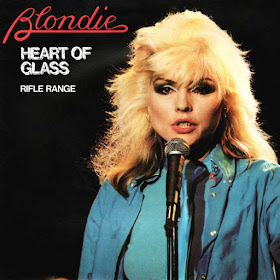Heart Of Glass broke Blondie worldwide and was a huge hit for them. Their first UK and US number 1, it also hit the top spot in Australia, Austria, Canada, Germany, New Zealand and Switzerland as well as making the Top 10 in Belgium, Ireland, the Netherlands, Norway, South Africa and Sweden. In the Year End charts, it was number 1 in New Zealand, number 2 in Canada and the UK and number 3 in Australia (and ranked 32nd in the UK chart for the whole of the 1970s). It has sold over 3.5m copies to date and was certified Gold in France, Germany and the US, Platinum in the UK and 2xPlatinum in Canada.
The basis of the song, then known as Once I Had A Love, was written by Debbie Harry & Chris Stein between 1974 and 1975. “[It] was one of the first songs Blondie wrote,” Debbie told Dave Simpson of The Guardian in April 2013, “but it was years before we recorded it properly. We’d tried it as a ballad, as reggae, but it never quite worked.” As work progressed on Parallel Lines, producer Mike Chapman “asked us to play all the songs we had. Sheepishly, we said, “Well, there is this old one.” Chapman liked it (“he thought it was very pretty,” said Debbie) and the band started to work on it.
Chapman credits Debbie with giving it a more disco twist, she says he convinced her and Stein of it. In an interview with the NME (dated 4th February 1978), Debbie mentioned she liked Giorgio Moroder’s disco work - “It’s commercial, but it's good, it says something, that's the kind of stuff that I want to do” - and Blondie covered I Feel Love (written by Moroder and Donna Summer) at a benefit for Johnny Blitz in New York on 7th May 1978.
“The boys in the band had got their hands on a new toy,” Debbie told The Guardian. Stein and keyboardist Jimmy Destri often visited a music shop on
“The lyrics weren’t about anyone, they were just a plaintive
moan about lost love,” Debbie told The Guardian. “I was tired of hearing girls singers write
or sing about being beaten by love,” she told Q. “So I said, well listen, there are also a lot
of girls who just walk away.”
Heart Of Glass was originally released as a 12” single in a
5:50 version but there were objections from US radio stations to the “pain in
the ass” lyric, which the 7” version cut down on. “At first,” Debbie told The Guardian, “the
song kept saying: 'Once I had a love, it was a gas. Soon turned out, it was a
pain in the ass.' We couldn't keep
saying that, so we came up with: 'Soon turned out, had a heart of glass.' We kept one 'pain in the ass' in - and the
BBC bleeped it out for radio.”
As well as being a hit, the song created some controversy
because of its disco sound and Blondie, at the forefront of New York ’s growing new wave music scene,
were accused of selling out. “People got
nervous and angry about us bringing different influences into rock,” Debbie
told The Guardian. “Although we'd
covered Lady Marmalade and I Feel Love at gigs, lots of people were mad at us
for 'going disco' with Heart of Glass.” Stein
said, “As far as I was concerned, disco was part of R&B, which I'd always
liked. The Ramones went on about us "going disco", but it was
tongue-in-cheek. They were our friends.”
Although it includes a shot of the legendary nightclub Studio 54, the
video - directed by Stanley Dorfman - was filmed in “a short-lived club called
the Copa or something,” said Stein.
Opening with footage of a nighttime New York , it then becomes a performance
piece, focussing on Debbie (often with that wonderful disinterested expression
she has) but also showing a lot of the band, especially in the wide shots. “I wanted to dance around,” she told The
Guardian, “but they told us to remain static, while the cameras moved around. God only knows why. Maybe we were too clumsy.”
Her dress was designed by her friend Stephen Sprouse, while she created the bands
T-shirts. “Everyone says I look iconic
and in control,” she said, “but I prefer our other videos.”
The song was issued as a single both as a 7” (backed with
Rifle Range (Stein, Ronnie Toast) in the UK and 11:59 (Destri) in the US) and
12” (Rifle Range again and the Heart Of Glass instrumental in the UK,
while the US version only included the instrumental).
Happy 40th, Heart Of Glass
sources:
UK chart positions
"How We Made Heart Of Glass" in The Guardian
Cover art
Happy 40th, Heart Of Glass
sources:
UK chart positions
"How We Made Heart Of Glass" in The Guardian
Cover art










































